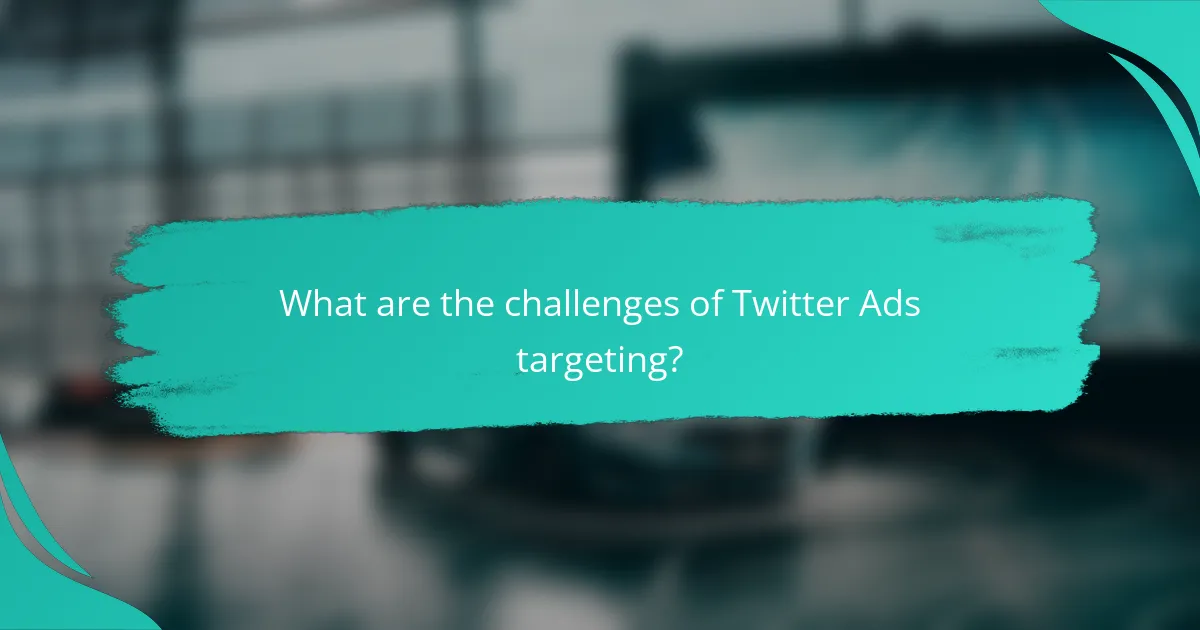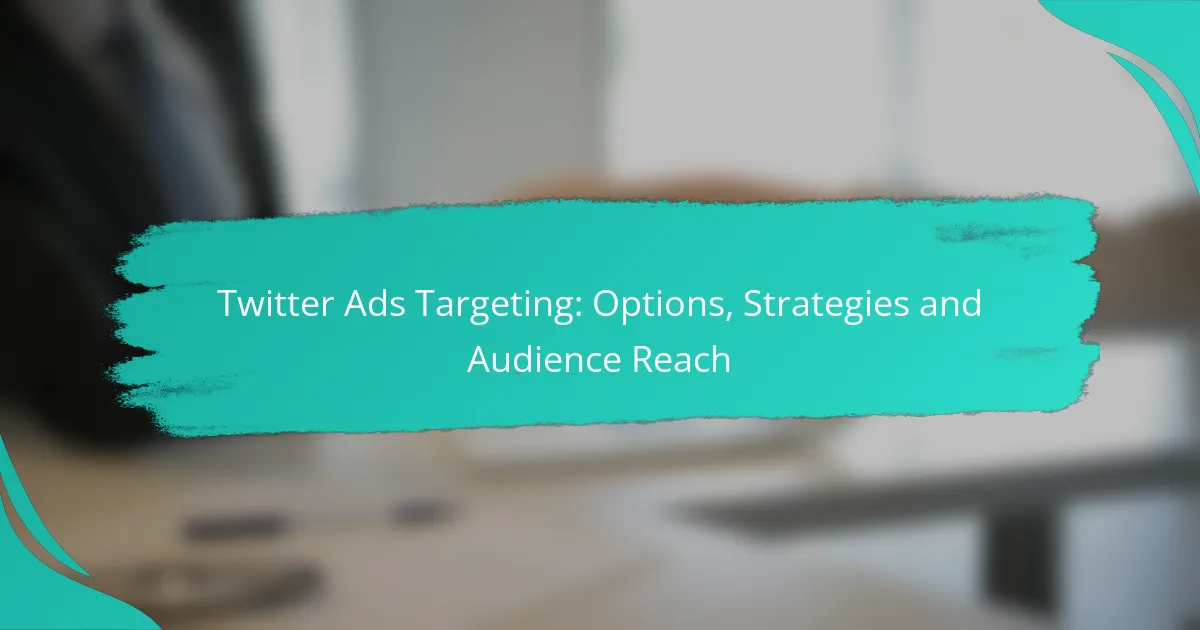Twitter Ads offer a powerful platform for advertisers to reach targeted audiences through a variety of strategies, including demographic, interest-based, and behavioral targeting. By combining these options with insights into audience behavior and trending topics, advertisers can enhance the relevance and effectiveness of their campaigns. Continuous optimization and precise audience segmentation are key to maximizing reach and engagement on this dynamic platform.

How to effectively target audiences with Twitter Ads in the UK?
To effectively target audiences with Twitter Ads in the UK, advertisers should leverage a combination of demographic, interest-based, behavioral, custom, and lookalike audience strategies. This multi-faceted approach allows for precise audience segmentation, enhancing the relevance and impact of ad campaigns.
Demographic targeting options
Demographic targeting on Twitter allows advertisers to reach users based on specific characteristics such as age, gender, location, and language. In the UK, you can refine your audience by selecting age ranges like 18-24 or 25-34, and by specifying regions such as London or Manchester.
Consider the implications of your demographic choices. For example, targeting younger audiences may yield higher engagement rates for tech products, while older demographics might respond better to financial services. Always align your ad content with the demographic profile you choose.
Interest-based targeting strategies
Interest-based targeting enables advertisers to reach users based on their interests and hobbies, which Twitter identifies through user behavior and engagement. Options include categories like sports, technology, and entertainment, allowing for tailored messaging that resonates with specific audience segments.
To maximize effectiveness, regularly review and update your interest categories based on trending topics and user engagement patterns. This ensures your ads remain relevant and appealing to your target audience’s current interests.
Behavioral targeting techniques
Behavioral targeting focuses on users’ past actions on Twitter, such as the accounts they follow and the tweets they engage with. This technique helps advertisers reach users who have shown interest in similar products or services, increasing the likelihood of conversion.
Utilize Twitter’s analytics tools to track user behavior and adjust your targeting accordingly. For instance, if you notice high engagement from users who follow competitors, consider crafting ads that highlight your unique selling points to capture their attention.
Custom audience targeting
Custom audience targeting allows advertisers to upload their own customer lists to Twitter, enabling them to reach existing customers or leads. This is particularly useful for retargeting campaigns aimed at users who have previously interacted with your brand.
Ensure your customer data complies with privacy regulations, such as the UK GDPR. Tailor your messaging for these audiences, focusing on promotions or new offerings that encourage repeat engagement or conversions.
Lookalike audience strategies
Lookalike audience strategies involve targeting users who share similar characteristics with your existing customers. By creating a lookalike audience, you can expand your reach to potential customers who are likely to be interested in your products or services.
To implement this, use Twitter’s tools to analyze your current audience and identify key traits. This strategy can significantly enhance your campaign’s effectiveness by connecting with users who have a higher propensity to convert, based on their similarities to your best customers.

What are the key strategies for maximizing Twitter Ads reach?
To maximize Twitter Ads reach, focus on leveraging audience insights, engaging with trending topics, and optimizing ad formats for better interaction. These strategies help ensure that your ads are seen by the right people at the right time, enhancing overall campaign effectiveness.
Utilizing Twitter’s audience insights
Twitter’s audience insights provide valuable data about user demographics, interests, and behaviors. By analyzing this information, advertisers can tailor their campaigns to target specific segments more effectively, increasing the likelihood of engagement.
Consider using tools like Twitter Analytics to track performance metrics and audience engagement. This data can inform adjustments to your targeting strategy, helping to refine your approach and improve ad relevance.
Engaging with trending topics
Capitalizing on trending topics can significantly boost your ad’s visibility. By aligning your content with current conversations, you can capture the attention of users who are already interested in those subjects.
Monitor Twitter’s trending section regularly and create ads that resonate with these themes. However, ensure that your messaging remains authentic and relevant to your brand to avoid appearing opportunistic.
Optimizing ad formats for engagement
Different ad formats on Twitter can yield varying levels of engagement. Experiment with formats such as Promoted Tweets, Video Ads, and Carousel Ads to see which resonates best with your audience.
For instance, video content often garners higher engagement rates compared to static images. Test different formats and analyze performance to determine the most effective options for your campaigns.

What are the best practices for Twitter Ads targeting?
The best practices for Twitter Ads targeting involve understanding your audience, utilizing precise targeting options, and continuously optimizing your campaigns. By focusing on demographics, interests, and behaviors, you can effectively reach the right users and enhance your ad performance.
Creating compelling ad copy
Compelling ad copy is crucial for capturing attention and driving engagement on Twitter. Use clear, concise language that resonates with your target audience, and highlight the unique benefits of your product or service. Incorporating a strong call-to-action can significantly increase click-through rates.
Consider using emotional triggers or addressing pain points to make your message more relatable. For example, if you’re promoting a fitness app, emphasize how it can help users achieve their health goals efficiently. Keep your copy within Twitter’s character limit to ensure it is fully visible.
Utilizing A/B testing for ads
A/B testing, or split testing, allows you to compare different versions of your ads to determine which performs better. By testing variations in headlines, images, and calls-to-action, you can identify the most effective elements for your audience. Start with small changes to isolate variables and gather meaningful data.
Set a clear objective for each test, such as increasing engagement or conversions. Monitor the results over a reasonable period, typically a few days to a week, to account for fluctuations in user behavior. Use the insights gained to refine your targeting and improve future campaigns.

What metrics should be tracked for Twitter Ads performance?
Tracking key metrics for Twitter Ads performance is essential to understand the effectiveness of your campaigns. Focus on metrics such as click-through rate, conversion rate, and engagement metrics to gauge how well your ads resonate with your target audience.
Click-through rate (CTR)
Click-through rate (CTR) measures the percentage of users who click on your ad after seeing it. A higher CTR indicates that your ad is compelling and relevant to your audience. Aim for a CTR in the low to mid-single digits, as this is often considered a good benchmark for Twitter Ads.
To improve CTR, ensure your ad copy is clear and includes a strong call to action. Test different images and messaging to see what resonates best with your audience.
Conversion rate analysis
Conversion rate analysis tracks the percentage of users who complete a desired action after clicking your ad, such as making a purchase or signing up for a newsletter. A good conversion rate can vary widely depending on the industry, but generally, rates between 2% and 5% are considered effective.
To enhance conversion rates, optimize your landing pages for user experience and ensure they align with your ad messaging. Consider using A/B testing to identify which elements drive the most conversions.
Engagement metrics
Engagement metrics include likes, retweets, replies, and shares, reflecting how users interact with your ads. High engagement levels can indicate that your content is resonating well with your audience, which can lead to increased brand awareness and loyalty.
Monitor these metrics to understand which types of content generate the most interaction. Engaging visuals and thought-provoking questions can significantly boost engagement rates. Regularly review and adjust your strategy based on these insights to maintain audience interest.

How do Twitter Ads compare to other social media platforms in the UK?
Twitter Ads offer unique targeting capabilities that differ from other social media platforms like Facebook and Instagram. While Twitter excels in real-time engagement and trending topics, Facebook and Instagram provide more detailed demographic targeting options, making them suitable for different marketing strategies.
Facebook Ads targeting options
Facebook Ads provide extensive targeting options, allowing advertisers to reach specific audiences based on demographics, interests, behaviors, and location. Advertisers can utilize Custom Audiences to retarget users who have interacted with their brand, or lookalike audiences to find new customers similar to their existing ones.
In the UK, Facebook’s targeting can be particularly effective for local businesses, as it allows for geo-targeting down to specific postcodes. This means you can tailor your ads to reach users in a defined area, enhancing the relevance of your campaigns.
Instagram Ads engagement strategies
Instagram Ads focus on visually engaging content, making it essential to use high-quality images and videos to capture attention. Strategies such as using Stories and Reels can significantly increase engagement, as these formats are designed for quick, impactful viewing.
In the UK, leveraging influencers can also enhance your Instagram Ads strategy. Collaborating with local influencers can help you tap into their established audiences, driving higher engagement rates and brand awareness. Aim for authentic partnerships that resonate with your target demographic for the best results.

What are the challenges of Twitter Ads targeting?
Twitter Ads targeting presents several challenges, including ad fatigue and intense competition for audience attention. Advertisers must navigate these obstacles to effectively reach and engage their desired audience.
Ad fatigue among users
Ad fatigue occurs when users see the same ads repeatedly, leading to decreased engagement and effectiveness. This can result in users ignoring or even blocking ads, which diminishes the overall impact of advertising campaigns.
To combat ad fatigue, rotate your ad creatives regularly and refresh your messaging. Consider using A/B testing to identify which variations resonate best with your audience, ensuring that your ads remain engaging and relevant.
Competition for audience attention
With countless brands vying for user attention on Twitter, competition is fierce. Advertisers must craft compelling content that stands out in a crowded feed, making it essential to understand audience preferences and behaviors.
Utilize Twitter’s targeting options to reach specific demographics and interests, but also focus on creating high-quality, visually appealing ads. Engaging visuals and clear calls-to-action can help capture attention and improve click-through rates.

What emerging trends are shaping Twitter Ads targeting?
Emerging trends in Twitter Ads targeting focus on enhanced personalization, data privacy, and the integration of artificial intelligence. Advertisers are increasingly leveraging user behavior and interests to create tailored ad experiences while navigating evolving privacy regulations.
Increased focus on user privacy
User privacy is becoming a priority for Twitter, affecting how advertisers can target audiences. With regulations like GDPR in Europe and CCPA in California, advertisers must ensure compliance while still reaching their desired demographics. This may involve using aggregated data or opting for contextual targeting instead of relying solely on personal data.
To adapt, brands should familiarize themselves with these regulations and consider implementing transparent data practices. Engaging users with clear consent mechanisms can build trust and improve ad performance.
Utilization of AI and machine learning
Artificial intelligence and machine learning are transforming Twitter Ads targeting by enabling more sophisticated audience segmentation and predictive analytics. These technologies help advertisers identify patterns in user behavior, allowing for more effective ad placements and content personalization.
Brands can leverage AI tools to analyze engagement metrics and optimize campaigns in real-time. This approach can lead to improved ROI, as ads become more relevant to users’ interests and behaviors.
Emphasis on video and multimedia content
As Twitter users increasingly engage with video and multimedia content, advertisers are shifting their strategies to incorporate these formats. Video ads can capture attention more effectively and convey messages in a dynamic way, leading to higher engagement rates.
Brands should consider creating short, impactful video content that aligns with their target audience’s preferences. Utilizing Twitter’s unique features, such as Fleets or live broadcasts, can further enhance visibility and interaction.
